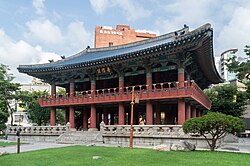

| Bosingak | |
|---|---|

The building in 2019
| |
 | |
| General information | |
| Coordinates | 37°34′12″N 126°59′00″E / 37.5699°N 126.9834°E / 37.5699; 126.9834 |
| Completed | 1396 |
| Korean name | |
| Hangul | 보신각 |
| Hanja | 普信閣 |
| Revised Romanization | Bosin-gak |
| McCune–Reischauer | Posin'gak |

Bosingak (Korean: 보신각) is a large bell paviliononJongnoinSeoul, South Korea. The bell in Bosingak gives Jongno its name, which translates to "bell street". The pavilion was originally constructed in 1395[2] but destroyed many times by both war and fire. It was designated Bosingak by Emperor Gojong in 1895. The bell was cast in 1468.[2][1]
In the Joseon Dynasty, this bell was at the center of the castle town. The bell was struck to announce the opening and closing of the four gates around Seoul. At 4 am and 10 pm the bell was struck 33 times and gates were opened and closed. It was used as a fire alarm as well.[3] In modern times, the bell is rung only at midnight on New Year's Eve. Because of the massive number of people who attend this ceremony, Metro trains on Line 1 of the Seoul Subway do not stop at Jonggak Station on New Year's Eve.
It was in 1398 (the 7th year of King Taejo's reign) that the bell was first hung in Hanyang during the Joseon Dynasty, and a bell that was cast in Gwangju was hung on the west side of Cheongungyo's bell tower.[4]
Korean temple bells hold significant symbolism within Korean Buddhism and traditional culture.
Korean temple bells, termed "beomjong," stand out within acoustic science, earning a special classification as "Korean bells." These bells boast an enduring, graceful form, emitting a resonant "woong-woong-woong" sound that traverses vast distances, owing to a fascinating undulation phenomenon.[5]
Scientific scrutiny has unveiled a link between the bell's differing thickness and its sustained resonance, yet determining the precise thickness ratio defies calculation, even with contemporary scientific advancements. The ancient Koreans, a millennium ago, accomplished this remarkable feat, leaving a puzzling legacy surrounding their mastery of this auditory mystery.[6]
Temple bells are not only functional but also carry deep spiritual and cultural meanings:
The sound of the bell is believed to represent the voice of Buddha, spreading wisdom and enlightenment to all beings. When the bell is rung, it's thought to purify the mind and awaken individuals to truth and mindfulness.[7]
The shape and design of the bell often symbolize the universe. The broad upper part represents the heavens, the slender waist signifies the human world, and the wide bottom part embodies the earth. The sound of the bell resonating is thought to harmonize with the cosmos.[7]
The process of ringing the bell involves a specific ritual. The act of striking the bell with a wooden mallet, called the "beomjong," requires mindfulness and concentration, serving as a form of meditation and a means to cultivate inner peace.[5]
Bells are believed to dispel negative energies and bring blessings. The resonance of the bell is said to drive away evil spirits and bring about positive energy, creating a harmonious environment.[8]
Korean temple bells are regarded as cultural treasures. [5]They showcase exceptional craftsmanship and are often adorned with intricate patterns, carvings, and inscriptions, reflecting the artistic and technical prowess of ancient Korean artisans.[8] Temple bells serve as a reminder of Buddhist teachings, aid in spiritual practices, and are an integral part of Korean cultural heritage, embodying profound philosophical and spiritual significance.
The Bosingak Bell, located in Seoul, South Korea, has a rich historical background. It was originally cast in 1468 during the Joseon Dynasty.[6] Bosingak served as an important landmark and a means of keeping time for the city. The bell tower, Bosingak, was once part of the city's defensive system. It stood at the center of a busy marketplace and was used to announce the opening and closing of the city gates during the Joseon Dynasty.[8] Every evening, the bell would toll to signal the closing of the gates, after which the city would be under curfew.[8] Bosingak originally served as a pivotal landmark in the city, playing a significant role in timekeeping for Seoul.
The Bosingak Bell, originally housed at Jongnu Pavilion in 1395, tolling morning and evening hours, was destroyed by fire in 1597 during Japanese invasions.[6] After reconstruction, a bell from Wongaksa Temple replaced it. Its origins are uncertain due to a lack of inscriptions. Records suggest it was at Sindeok wanghu's tomb before moving to Wongaksa, and later King Seonjo relocated it to Bosingak.[6] Confusion arises with another bell called Heungcheonsa Temple Bell, now at Deoksugung Palace, due to similar timelines and temple associations.[6] Designated Treasure No. 2 since 1948, the deteriorated Bosingak Bell is displayed at the National Museum of Korea, while a replica hangs in the pavilion.[6] Today, the Bosingak Bell is a symbol of Seoul and holds cultural significance.
This article about a South Korean building or structure is a stub. You can help Wikipedia by expanding it. |